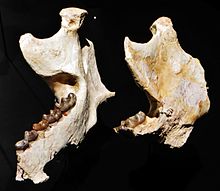Daouitherium
- View a machine-translated version of the German article.
- Machine translation, like DeepL or Google Translate, is a useful starting point for translations, but translators must revise errors as necessary and confirm that the translation is accurate, rather than simply copy-pasting machine-translated text into the English Wikipedia.
- Consider adding a topic to this template: there are already 1,970 articles in the main category, and specifying
|topic=will aid in categorization. - Do not translate text that appears unreliable or low-quality. If possible, verify the text with references provided in the foreign-language article.
- You must provide copyright attribution in the edit summary accompanying your translation by providing an interlanguage link to the source of your translation. A model attribution edit summary is
Content in this edit is translated from the existing German Wikipedia article at [[:de:Daouitherium]]; see its history for attribution. - You may also add the template
{{Translated|de|Daouitherium}}to the talk page. - For more guidance, see Wikipedia:Translation.
| Daouitherium Temporal range: Early Eocene | |
|---|---|
 | |
| Lower jaws | |
| Scientific classification | |
| Domain: | Eukaryota |
| Kingdom: | Animalia |
| Phylum: | Chordata |
| Class: | Mammalia |
| Order: | Proboscidea |
| Family: | †Numidotheriidae |
| Genus: | †Daouitherium Gheerbrant & Sudre, 2002 |
| Species: | †D. rebouli |
| Binomial name | |
| †Daouitherium rebouli Gheerbrant & Sudre, 2002 | |

Daouitherium ("Sidi Daoui beast" from the name of the site where it was discovered) is an extinct genus of early proboscideans (a group including modern elephants and their extinct relatives) that lived during the early Eocene (Ypresian stage) some 55 million years ago in North Africa.
Remains of this animal, fragments of jaws and teeth, have been found in the Ouled Abdoun Basin in Morocco. It is estimated to have weighed between 80 and 170 kg (180 and 370 lb), making it one of the earliest large mammals known from Africa and one of the oldest known proboscideans.[1] Another estimate gives a weight of 200 kg (440 lb).[2]
Description
Daouitherium is known only from lower jaws and associated cheek teeth. It had lophodont and bilophodont molars, i.e. molars with large ridges. The second and third premolars had a notably large cusp called the hypoconid. Gheerbrant et al. described the teeth as similar to those of other early proboscideans Phosphatherium, Numidotherium, and Barytherium.[1]
See also
References
- ^ a b Gheerbrant, E.; Sudre, J.; Cappetta, H.; Iarochène, M.; Amaghzaz, M.; Bouya, B. (2002). "A new large mammal from the Ypresian of Morocco: Evidence of surprising diversity of early proboscideans" (PDF). Acta Palaeontologica Polonica. 47 (3): 493–506.
- ^ Larramendi, A. (2016). "Shoulder height, body mass and shape of proboscideans" (PDF). Acta Palaeontologica Polonica. 61. doi:10.4202/app.00136.2014.
- v
- t
- e
- Kingdom: Animalia
- Phylum: Chordata
- Class: Mammalia
- Superorder: Afrotheria
- Clade: Tethytheria
| |||||||||||||||||||||||||||



 | This article about a prehistoric proboscidean is a stub. You can help Wikipedia by expanding it. |
- v
- t
- e










